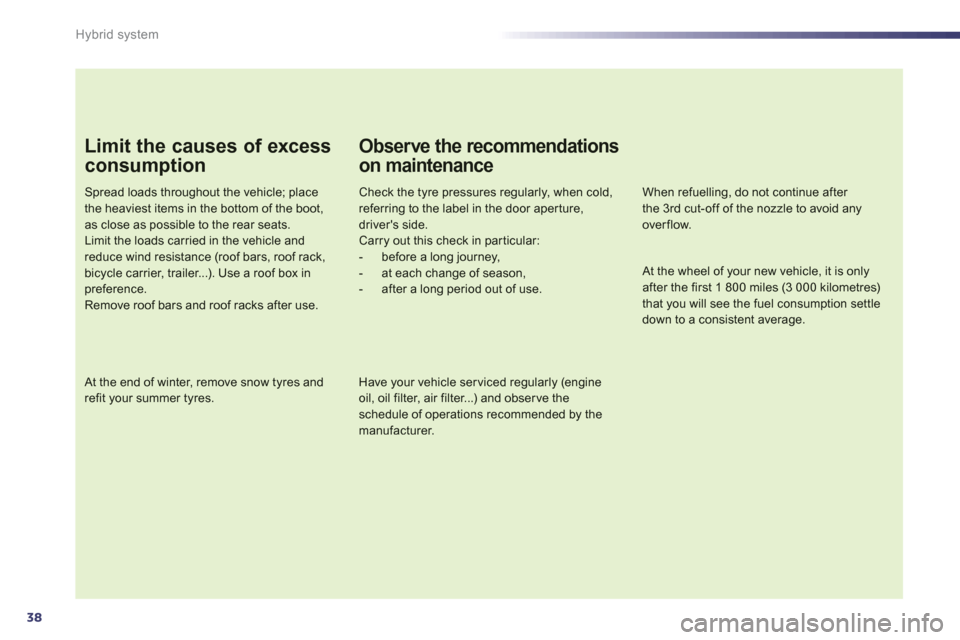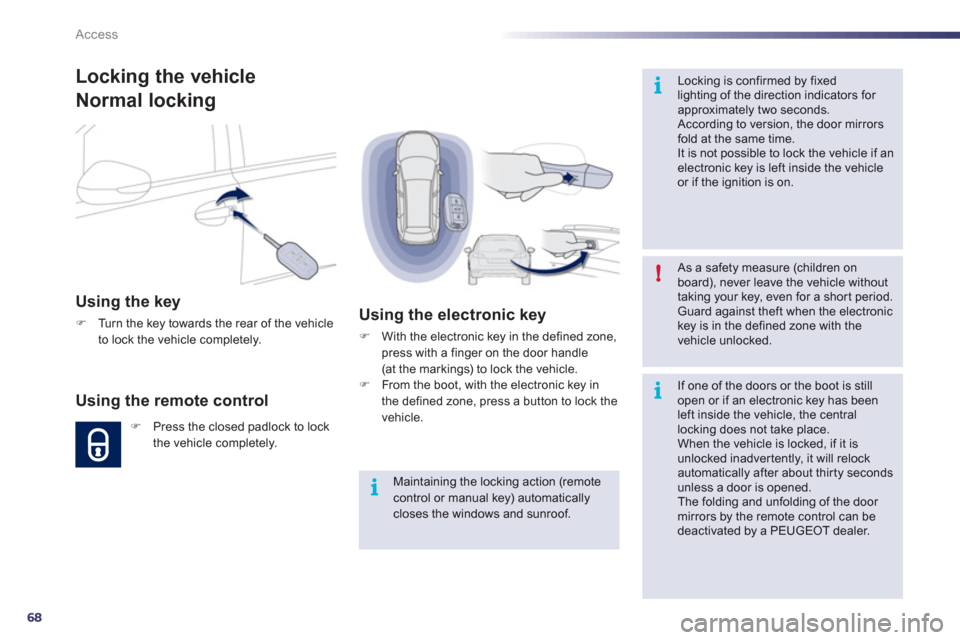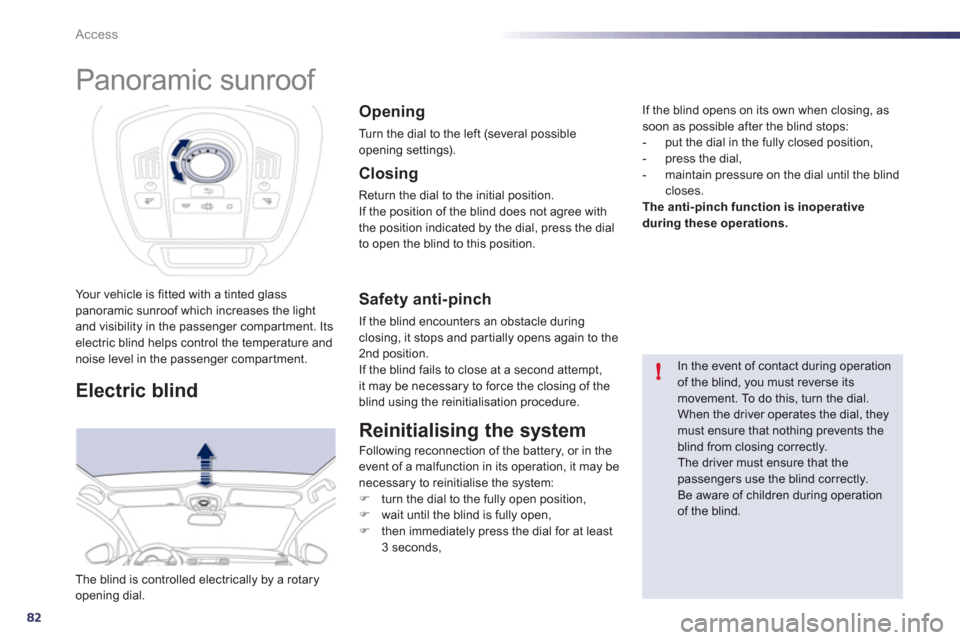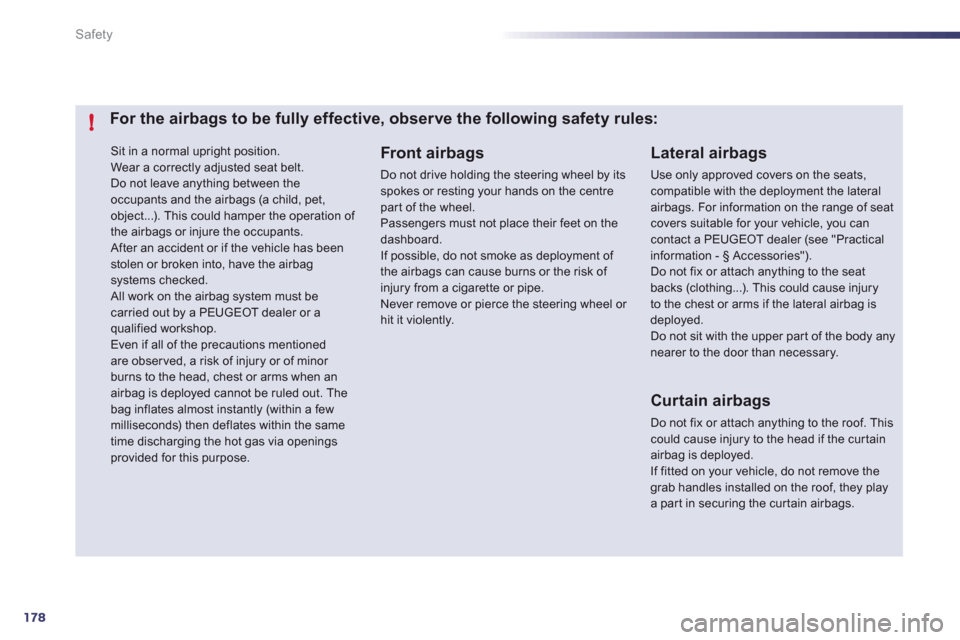roof Peugeot 508 RXH 2012 Owner's Manual
[x] Cancel search | Manufacturer: PEUGEOT, Model Year: 2012, Model line: 508 RXH, Model: Peugeot 508 RXH 2012Pages: 302, PDF Size: 9.33 MB
Page 4 of 302

.
.
Contents
Instrument panel 45
Indicator and warning lamps 46
Gauges and indicators 57
Tr ip computer 62
Instruments and controlsFamiliarisation
Remote control key 65
Alarm 74
El
ectric windows 76
Boot 78
Motorised tailgate 79
Panoramic sunroof 82
Fuel tank 83
Diesel misfuel prevention 84
Access
Front seats 86
Rear seats 90
Mirrors 92
Steering wheel adjustment 94
Interior fi ttings 95
Boot fi ttings 98
Heating and Ventilation 104
Manual air conditioning 106
Dual-zone digital air conditioning 108
Quad-zone digital air conditioning 111
Rear screen demist - defrost 116
Programmable Heating/Ventilation 117
Comfort
Electric parking brake 118
6-speed electronic gearbox system 125
Hill start assist 129
Head-up display 130
Speed limiter 133
Cruise control 135
Parking sensors 137
Parking space sensors 139
Driving
Lighting controls 141
LED lamps 144
Automatic illumination of headlamps 146
Headlamp adjustment 149
Directional lighting 150
Wiper controls 151
Automatic rain sensitive wipers 153
Cour tesy lamps 155
Interior mood lighting 156
Visibility Hybrid system
Presentation 22
Starting/switching off your vehicle 25
Ready lamp 29
HYbrid4 mode selector 29
Energy consumption/generation indicator 32
Display of hybrid power fl ow 33
Eco off 36
Eco-driving 37
Consumption 39
High voltage battery 40
Vehicle recovery 44
Page 5 of 302

.
.
Contents
Child seats 157
ISOFIX child seats 163
Child lock 166
Child safety
Direction indicators 167
Emergency or assistance call 168
Horn 168
ESP system 169
Seat belts 172
Airbags 175
Safety
Te m p o r a ry puncture repair kit 179
Changing a wheel 185
Changing a bulb 190
Changing a fuse 197
12 V battery 201
Energy economy mode 204
Changing a wiper blade 205
Recovering the vehicle 206
Vehicle recovery 208
To w i ng a trailer 209
Fitting roof bars 211
Accessories 212
Practical information
Opening the bonnet 215
Running out of fuel (Diesel) 216
Diesel engine 217
Checking levels 218
Checks 221
Checks
Electric motor 224
Diesel engine 225
Diesel weights 226
Dimensions 227
Identifi cation markings 228
Technical data
Emergency or assistance 229
JBL equipment 231
Peugeot Connect Navigation (RT6) 233
Audio equipment and telematics
Alphabetical index
Visual search
Page 7 of 302

.
5
Familiarisation
For economical driving, caring for the environment
The fuel consumptionof a vehicle varies greatly:
- according to the driver's style of driving
(moderate, aggressive, fast, ...),
- according to the type of journeys
made (urban, main road, motorway, flowing, heavy traffic, …) and the speed.
Main recommendations for driving economically
Hybrid mode selector
To optimise fuel consumption, use the Automodeof the selector whenever possible (the mode is activated
automatically when starting) including for urban journeys.
This mode optimises the use of the energy sources (internal combustion engine and/or electric) contrary to other modes, which are for use in par ticular cases.
Gear lever
Use the automatic
mode A
as much as possible as this optimises gear changes to suit the requirements.
Drive smoothly
Stay in the "eco" zone
displayed in the energy consumption/generation indicator: accelerate gently, drive atsteady speeds using the speed limiter or cruise control as soon as possible. Use the "charge" zone
: anticipate the need to slow down by taking your foot off the accelerator rather than
braking. The movement of the energy consumption/generation indicator needle (into the "charge" zone), shows
the level of energy recovery.
Consumption history
See the impact of your style of driving and the type of journey by reviewing the history of your energyconsumption. Refer to the "Multifunction screens" section.
Causes of high consumption and checks
As with any vehicle, limit overloading, wind resistance (windows open above 30 mph (50 km/h), roof rack, loaded
or not, …), the use of power consumers (air conditioning, heated seats, heated rear screen, …).
Obser ve the recommendations on checks (regular check of tyre pressures, correct tyre pressures, …) and routine servicing.
Page 39 of 302

.
37
Hybrid system
Eco-driving
Eco-driving is a range of everyday practices that allow the motorist to optimise their fuel consumption and CO2 emissions.
Optimise the use of your
gearbox
Use automatic mode Aas much as possible as this optimises gear changes to suit the
circumstances.
Drive smoothly
Maintain a safe distance between vehicles, use engine braking rather than the brake pedal, and press the accelerator progressively. These practices contribute towards a reduction in fuel consumption and CO2 emissions and also helps reduce thebackground traffic noise.
If your vehicle has cruise control, make use of the system at speeds above 25 mph (40 km/h) when the traffic is flowing well.
Control the use of your
electrical equipment
Before moving off, if the passenger compartment is too warm, ventilate it byopening the windows and air vents before using the air conditioning.
Above 30 mph (50 km/h), close the windowsand leave the air vents open. Remember to make use of equipment that canhelp keep the temperature in the passenger compartment down (sun roof and window blinds...).Switch off the air conditioning, unless it has automatic digital regulation, as soon as the desired temperature is attained.Switch off the demisting and defrosting controls, if not automatic.
Switch off the heated seat as soon as possible.
Switch off the headlamps and front foglampswhen the level of light does not require their use.
Avoid running the Diesel engine when stationary, par ticularly in winter; your vehiclewill warm up much faster while driving.
As a passenger, if you avoid connecting your multimedia devices (film, music, video game...), you will contribute towards limitingthe consumption of electrical energy, and soof fuel.
Disconnect your por table devices beforeleaving the vehicle.
Page 40 of 302

38
Hybrid system
Limit the causes of excess
consumption
Spread loads throughout the vehicle; placethe heaviest items in the bottom of the boot,as close as possible to the rear seats.Limit the loads carried in the vehicle andreduce wind resistance (roof bars, roof rack,bicycle carrier, trailer...). Use a roof box in preference.Remove roof bars and roof racks after use.
At the end of winter, remove snow tyres and refit your summer tyres.
Observe the recommendations
on maintenance
Check the tyre pressures regularly, when cold, referring to the label in the door aper ture, driver's side. Carry out this check in par ticular:
- before a long journey,
- at each change of season,
- after a long period out of use.
Have your vehicle ser viced regularly (engine oil, oil filter, air filter...) and obser ve the schedule of operations recommended by the
manufacturer.
When refuelling, do not continue after the 3rd
cut-off of the nozzle to avoid any overflow.
At the wheel of your new vehicle, it is onlyafter the first 1 800 miles (3 000 kilometres) that you will see the fuel consumption settle down to a consistent average.
Page 70 of 302

68
i
!
i
i
Access
As a safety measure (children on board), never leave the vehicle without taking your key, even for a shor t period.
Guard against theft when the electronickey is in the defined zone with thevehicle unlocked.
Locking is confirmed by fixedlighting of the direction indicators for approximately two seconds. According to version, the door mirrors fold at the same time.
It is not possible to lock the vehicle if an electronic key is left inside the vehicleor if the ignition is on.
If one of the doors or the boot is stillopen or if an electronic key has been left inside the vehicle, the centrallocking does not take place.
When the vehicle is locked, if it isunlocked inadvertently, it will relock automatically after about thir ty seconds unless a door is opened.
The folding and unfolding of the door mirrors by the remote control can be deactivated by a PEUGEOT dealer.
Locking the vehicle
Normal locking
Using the key
�)Turn the key towards the rear of the vehicle
to lock the vehicle completely.
Using the remote control
�)Press the closed padlock to lock
the vehicle completely.
Using the electronic key
�)
With the electronic key in the defined zone,
press with a finger on the door handle(at the markings) to lock the vehicle.�) From the boot, with the electronic key in
the defined zone, press a button to lock the
v
ehicle.
Maintaining the locking action (remotecontrol or manual key) automaticallycloses the windows and sunroof.
Page 84 of 302

82
!
Access
Panoramic sunroof
Your vehicle is fitted with a tinted glass panoramic sunroof which increases the lightand visibility in the passenger compartment. Itselectric blind helps control the temperature andnoise level in the passenger compartment.
Electric blind
The blind is controlled electrically by a rotaryopening dial.
Opening
Turn the dial to the left (several possible
opening settings).
In the event of contact during operationof the blind, you must reverse its movement. To do this, turn the dial.
When the driver operates the dial, theymust ensure that nothing prevents theblind from closing correctly. The driver must ensure that the passengers use the blind correctly.
Be aware of children during operationof the blind.
Closing
Return the dial to the initial position.
If the position of the blind does not agree with
t
he position indicated by the dial, press the dialto open the blind to this position.
Safety anti-pinch
If the blind encounters an obstacle duringclosing, it stops and par tially opens again to the 2nd position.
If the blind fails to close at a second attempt,
it may be necessary to force the closing of the blind using the reinitialisation procedure.
Reinitialising the system
Following reconnection of the battery, or in the event of a malfunction in its operation, it may be
necessary to reinitialise the system:
�) turn the dial to the fully open position, �)
wait until the blind is fully open,�)
then immediately press the dial for at least
3 seconds,
If the blind opens on its own when closing, as soon as possible after the blind stops:
- put the dial in the fully closed position,
- press the dial,
- ma
intain pressure on the dial until the blindcloses. The anti-pinch function is inoperative
during these operations.
Page 104 of 302

102
i
Comfort
High load retaining net
Hooked onto the special upper and lower
fixings, this allows the use of the entire loadingvolume up to the roof:
- behind the front seats (row 1) when the rear seats are folded.
- behind the rear seats (row 2).
Never reposition the rear seats if thenet's roller is attached to the backs of the folded seats. �)
position the net's roller above the two rails (located on the back of the folded rear seats),�)
the two grooves Amust be placed above
the two rails B
. Slide the two rails B
in the grooves A
and push the roller (lengthwise)from right to left to secure it,
�)
check that the net is hooked and tightened correctly,
�)fold the rear seats, �)unroll the high load retaining net withoutstretching it, �)position one of the ends of the net's metal
bar in the corresponding upper fixing 1,�)pull the net's metal bar to position the other end in the other upper fixing 1 .
Row 1
Page 180 of 302

178
!
Safety
Sit in a normal upright position.
Wear a correctly adjusted seat belt.
Do not leave anything between theoccupants and the airbags (a child, pet,object...). This could hamper the operation of the airbags or injure the occupants. After an accident or if the vehicle has beenstolen or broken into, have the airbagsystems checked. All work on the airbag system must be carried out by a PEUGEOT dealer or a qualified workshop.
Even if all of the precautions mentioned are obser ved, a risk of injury or of minor burns to the head, chest or arms when an airbag is deployed cannot be ruled out. Thebag inflates almost instantly (within a few milliseconds) then deflates within the same
time discharging the hot gas via openings provided for this purpose.
Lateral airbags
Use only approved covers on the seats, compatible with the deployment the lateral airbags. For information on the range of seatcovers suitable for your vehicle, you can contact a PEUGEOT dealer (see "Practical information - § Accessories"). Do not fix or attach anything to the seat backs (clothing...). This could cause injuryto the chest or arms if the lateral airbag isdeployed.Do not sit with the upper par t of the body anynearer to the door than necessary.
Front airbags
Do not drive holding the steering wheel by its spokes or resting your hands on the centre part of the wheel.
Passengers must not place their feet on thedashboard.
If possible, do not smoke as deployment of the airbags can cause burns or the risk of injury from a cigarette or pipe.
Never remove or pierce the steering wheel or hit it violently.
Curtain airbags
Do not fix or attach anything to the roof. This
could cause injury to the head if the cur tain airbag is deployed. If fitted on your vehicle, do not remove thegrab handles installed on the roof, they play a par t in securing the cur tain airbags.
For the airbags to be fully effective, observe the following safety rules:
Page 201 of 302

8
199
Practical information
Fuse N°Rating (A)Functions
F3 15
Driver's electric window panel, 12 V socket for rear seats.
F
415
12 V socket in boot.
F530 One-touch rear window.
F
630 One-touch front window.
F1
120 Trailer unit.
F12 2
0 Audio amplifier.
F1
520 Panoramic sunroof blind.
F1
65 Driver's electric window switch panel.
Fuses behind the glove box